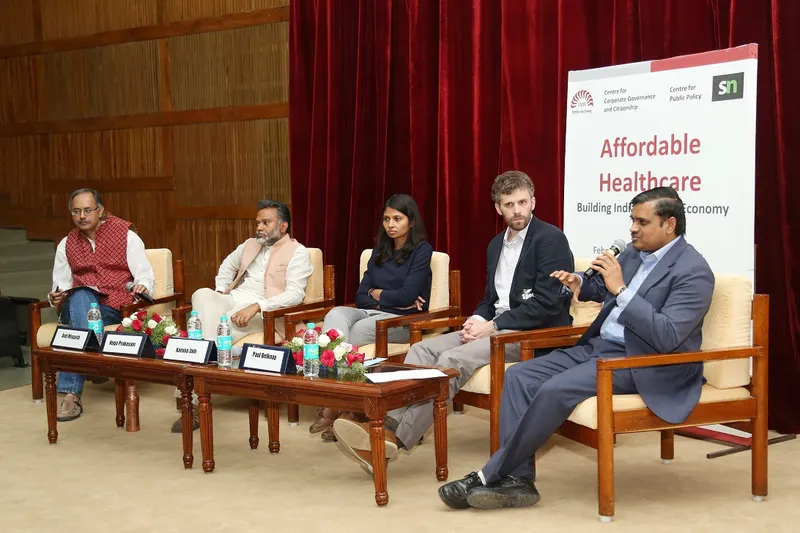Affordable Healthcare Conclave – a call for startups to solve India’s really hard problems. Are you ready?
India has a wide range of seemingly insurmountable obstacles in providing affordable healthcare to its vast population, but some solutions and successes have emerged. Scaling them up and coming up with more indigenous innovations, along with robust technology, are some ways ahead.

Healthcare experts, healthtech startups, academics and policymakers gathered at IIM Bangalore for the first Affordable Healthcare Conclave, put together by ManagementNext magazine and The Centre for Public Policy. The event will be held each year to assess and promote progress in the field (see Part I and Part II of YourStory’s preview coverage).
A world of challenges
India has massive healthcare gaps – there is a shortage of four million hospital beds, two million doctors, and four million nurses, according to Sudarshan Ballal, Chairman, Manipal Hospitals. The ratio of population to doctors is six times lower in rural India than urban India; 30 percent of the rural population has to walk an average of 30km to access medical facilities. “The saddest moment for a doctor is telling a patient that he has a disease which is treatable but not affordable,” Ballal lamented.
India’s levels of death and illness due to pollution are unacceptable, said Sujatha Rao, former Union Secretary of Health. Her book, Do We Care: India’s Health System, was launched at the conclave. Countries like China, Turkey and Thailand have gone far ahead of India in terms of health indicators, and offer useful lessons for India. More political leadership is needed in this vital sector, said Sujatha.
“Relying only on the private sector for healthcare will not work - just look at the fragmented nature of healthcare in the US,” she observed. “Education for doctors is free in Europe, they give stipends. Here, we rely heavily on private colleges, some of whom are fraudulent,” Rao said. Even the quality of education in India is lacking – many graduates still need training after they join the hospitals.
The health scenario is not even across India: some states such as Tamil Nadu spend three times more on healthcare than others, such as Bihar or Uttar Pradesh. Kerala is decades ahead of other states like Madhya Pradesh in life expectancy, according to Rao.
“Another challenge in India is quacks, who sell coloured water for Rs 5,” observed Sameer Sawarkar, co-founder and CEO, NeuroSynaptic. The debt trap ends up becoming a cruel death trap.

Solutions
A range of speakers identified some of the positive aspects of healthcare and innovation in India, such as Aravind eye lenses, Kalam stent, Somaraju stent, and Chitra valves. Notable achievements are the high reduction of HIV incidents, and the eradication of polio.
Ballal of Manipal Hospitals evocatively captured the ‘4 As’ of success for a broad-based healthcare system for India: availability, accessibility, affordability, and acceptability. India should invest more in healthcare, promote non-doctor education, and have medical colleges in each district hospital. India should promote preventive healthcare, use of generics, CSR in health, and innovation through technology and partnerships, Ballal advised.
“A wellness culture needs to be brought into India through education. India (and even the US) cannot treat all patients for all illnesses; we need preventive approaches,” Ballal said.
“We have launched affordable products based on Indian medicine, such as Liv52,” said Vijendra Prakash, In Charge - Regulatory Affairs, Himalaya Drug Company. He advocated more usage of Indian medicine in rural areas, as well as an integrative approach with Allopathy, Ayurveda, yoga, and so on.
The four pillars of health policy, according to Rao, are clarity of purpose, design, financing, and incentive structures. “Technology has a huge potential to make healthcare affordable in India,” she explained. India needs more sensitivity towards inequality, apathy, ignorance and abuse of rights. Ayurvedic practices also need more scientific and patenting rigour.
Doctors and healthcare activists in the audience had a number of suggestions as well: structure medical insurance in more effective ways; improve the quality of Ayurveda treatments, provide rural pharmacist training, ‘adopt a village’ and sustain healthcare practices, and even donate ‘one ambulance per village.’
The World Bank has published Going Universal, a useful report about healthcare in 24 developing countries. Effective universal health coverage is about including people, expanding benefits, managing money, improving supply, and strengthening accountability. The UN has also framed a set of Millennium Development Goals related to healthcare.
Healthcare reforms tend to be more of a ‘stepping stone’ nature than ‘big bang,’ observed Somil Nagpal, Senior Health Specialist, World Bank. Trends to watch out for include group purchase of benefits, digital IDs, performance-based payment, accreditation systems, and better data collection.

Healthcare and impact funding
A range of impact investors and successful entrepreneurs also offered insights into scaleable solutions via judicious investment strategies. Challenges for healthtech startups in India lie in lack of multi-disciplinary skills, partnership abilities, and scale-stage growth.
“We need to focus beyond trivial problems or rich people’s problems. We need more entrepreneurs to solve India’s really hard problems, such as affordable healthcare,” said Naga Prakasam, Mentor at NSRCE, IIMB. He is also an investor in Acumen Fund, and an active member at Indian Angel Network and Native Angels Network.
“Healthtech is more than an app,” he joked, pointing to the fad of smartphone as holy grail for all health solutions. “Healthcare expenses are primary drivers to push people into poverty. Healthcare costs push people into debt forever; this is unacceptable,” said Naga.
“The needy and marginalised in India are not the minority in healthcare – but the majority. We literally need ‘patient capital’ in India for long-term change in healthcare,” he said.
NeuroSynaptic has set up over 2,000 rural health centres with remote diagnostics. “Many people assume rural primary care should be government-funded only, but other models can exist. NGOs are active in this space, but many find challenges in scaling up,” said Sawarkar of NeuroSynaptic. “Regulations should help safety and quality but not make the market exclusive to incumbents,” he recommended.
Indeed, India is often described as a land of pilot projects. “How do we go beyond that to scale,” asked Anil Misquith, Executive Director, Strategic Initiatives, Samhita Social Ventures. Many NGOs do not get to see the recent innovations happening in healthtech, more awareness is needed.
“Healthcare has lots of intermediaries, there is a need to improve efficiencies of these resources,” said Karuna Jain, Associate Director and Global Health Lead, Acumen Fund. The company is focussed more on primary healthcare in India, and less on secondary and tertiary health.
“Simple well-designed products can have significant impact in healthcare,” said Paul Belknap, Investment Manager at Villgro Innovations Foundation. The company looks for hardware tech validation as well as evidence that the product fits in the doctor’s workflow, is accepted, and can reduce costs or increase access.

Startups and tech trends
The traditional healthcare model of standalone, Internet-based, reactive, and single type of service is now morphing into the transformative healthcare model, said Guruprasad S, Senior General Manager for Engineering Healthcare at Robert Bosch Engineering and Business Solutions. The new model is connected, powered by IoT, customised, and focussed on preventive healthcare and wellness.
To succeed in this space, startups should go beyond ‘happy engineering,’ he advised. “Startups should develop perseverance beyond the prototype, where the real world hits you,” said Guruprasad. The healthcare spectrum now spans prevention, diagnostics, therapeutic, and rehabilitation.
A range of mental ailments has also emerged in India, and online solutions have lots of potential in such a conservative society. “Our online counselling solution for depression is IP-protected, convenient, affordable and discreet,” said Sushil Eapen, CEO, Silver Oak Health.
More awareness about healthy lifestyles is needed. “My doctor friend says that no one has walked into my office to say, ‘I am healthy, how do I ensure I stay healthy?’” joked B. Subrahmanya, co-founder, FirstLife. The startup offers tracking solutions for diabetics. “Indians get diabetes 10 years earlier than their western counterparts. India is the diabetes capital of the world, and Bangalore is the diabetes capital city of the world,” he said.
The discussion at the end of the conclave revolved around problem-product validation, ecosystem partnerships, and data-centric analytics. Some founders observed that sometimes they need to prove a solution works abroad before locals accept it.
There were also pitches from four startups: Stasis Labs, 1Bridge, Dozee and MedYog. They offer solutions in areas like hospital patient tracking, sleep quality indicators, home diagnostics, and rural healthcare.
With more entrepreneur networks expanding in India and connecting to the broader ecosystem, the healthcare sector seems ready for change and transformation in the coming years.












